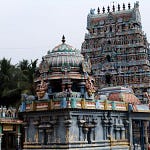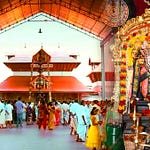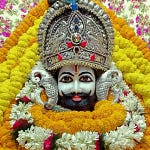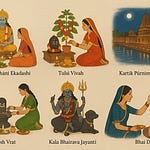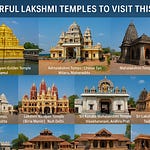Nestled in the spiritual heartland of Madhya Pradesh, just 30 kilometers from Indore city, lies an extraordinary and sacred site known as the Ulta Hanuman Mandir in Sanwer. This unique temple, dedicated to Lord Hanuman, draws thousands of devotees and pilgrims annually for one striking feature — the idol of Hanuman is inverted, standing on His head. Revered for its miraculous aura and powerful mythology, this temple is not only an architectural marvel but a spiritual powerhouse that blends legend, devotion, and mysticism.
1. Origin & Founding: The Mythological Dive into Patal Lok
The origin of the Ulta Hanuman Mandir is intricately tied to one of the most heroic tales from the Ramayana. As the legend goes, during the fierce battle between Lord Rama and Ravana, a powerful demon named Ahiravana kidnapped Lord Rama and Lakshmana and took them to Patal Lok (the netherworld). Upon learning of their abduction, Hanuman fearlessly plunged headfirst into Patal Lok, defeating Ahiravana and rescuing the divine brothers.
To honor this legendary act of inverted descent and divine valor, this temple enshrines Hanuman in an upside-down posture, symbolizing not only His daring rescue but also His boundless devotion to Rama.
2. Historical Timeline: An Ancient Beacon of Faith
Though precise records of the temple’s founding are scarce, oral traditions and local lore suggest that it has existed for several centuries. Over time, it has attracted attention from local rulers and religious patrons, undergoing periodic renovations and expansions.
This temple has stood the test of time — quietly serving as a spiritual sanctuary for generations. It is one of the few temples in India with such a rare and powerful visual representation of Hanuman.
3. Architecture & Design: A Temple Turned Upside Down
The architectural style of Ulta Hanuman Mandir reflects traditional Indian temple design with influences from local Nagara traditions. The temple's most distinctive feature is undoubtedly the idol of Hanuman standing on His head, a rare and symbolic depiction that captures the spirit of His mission to Patal Lok.
Apart from the main deity, the complex houses beautiful idols of Lord Rama, Sita, Lakshmana, and Shiva-Parvati. The sanctum is adorned with intricate carvings and motifs, and the space exudes serenity, devotion, and ancient energy.
4. Spiritual Significance: A Temple of Miracles and Devotion
The temple is widely believed to possess miraculous powers. Devotees swear by the tradition of visiting the temple on three or five consecutive Tuesdays, believing that such a practice can alleviate their sorrows, fulfill wishes, and bring peace to their lives.
The inverted Hanuman is more than an idol—it is a metaphor for humility, courage, and unwavering bhakti. His form reminds worshippers of divine surrender and the cosmic balance between the seen and the unseen.
5. Puja & Rituals: Devotion in Every Gesture
Daily rituals include traditional aartis, offerings, and prayers led by temple priests. On Tuesdays—considered especially sacred for Hanuman—special 'chola' offerings (a vermillion and oil paste ritual) are made by devotees as a sign of reverence.
The rituals are inclusive, often allowing families and individual devotees to participate, creating a sense of community and shared devotion.
6. Festivals Celebrated: Faith in Festivity
Hanuman Jayanti is the grandest celebration here, marked by processions, special pujas, and spiritual discourses.
Tuesdays and Saturdays consistently see a high influx of devotees.
Other Hindu festivals like Navratri and Diwali are also celebrated with grandeur.
The temple becomes a beacon of vibrant spiritual energy during these times.
7. Bhajans & Cultural Aspects: Soundscapes of Devotion
The air of the temple resonates with traditional Hanuman Bhajans, sung with devotion by groups using harmoniums, dholaks, and manjiras. On festive occasions, the temple hosts Ramleela performances, kirtans, and cultural plays depicting Hanuman's divine deeds.
These events aren't just performances—they are immersive spiritual experiences.
8. Aarti Timings & Daily Schedule
Morning Aarti: Around sunrise
Evening Aarti: At sunset
Darshan Timings: From early morning till night with breaks for rituals
For a peaceful darshan and meditative atmosphere, mornings on weekdays are ideal.
9. Special Satsangs, Functions, or Events
The temple occasionally organizes satsangs, spiritual discourses, and group prayers. During Hanuman Jayanti, special yagnas, bhandaras (free feasts), and cultural functions are held, attracting devotees from across Madhya Pradesh and beyond.
These events foster a deep sense of spiritual community and devotion.
10. Special Pujas & Mystical Beliefs
One of the most unique rituals is the offering of a chola to an inverted Hanuman idol—an act believed to bring resolution to complex life problems.
Many devotees report miraculous experiences, healing of ailments, and sudden positive changes in life circumstances after visiting the temple, strengthening its mystical reputation.
11. Devotee Experience: A Sacred Journey
Testimonials often speak of:
A sense of inner peace and spiritual fulfillment
Clean surroundings and cooperative temple staff
Vibrant and electrifying environment during aartis and festivals
Despite high footfalls on certain days, temple management ensures smooth crowd flow and darshan arrangements.
12. Travel & Visitor Information
Location: Sanwer, ~30 km from Indore, Madhya Pradesh
Nearest Airport: Devi Ahilya Bai Holkar Airport, Indore
Nearest Railway Station: Indore Junction
By Road: Taxis and local buses available from Indore to Sanwer
Accommodation: Hotels and guesthouses in Indore range from budget to luxury
Entry Rules: Modest attire is expected; no major restrictions
Guides: Local temple guides are available on-site
13. Other Details
Donations: Can be made in cash or in kind at temple counters
Prasadam: Typically includes sweets, laddoos, and chana prasad
Religious Stores: Small stalls outside the temple sell incense, idols, books, and religious items
Online Presence: No official site, but covered widely by religious news portals and YouTube channels
A Temple Like No Other
The Ulta Hanuman Mandir of Sanwer is more than a place of worship—it's a spiritual phenomenon, a symbol of devotion turned upside down to set things right. It challenges our perception of the divine with a posture that is unusual yet powerful, teaching that true strength lies in surrender.
For the spiritual traveler, the curious devotee, or the cultural explorer, this temple is an unforgettable journey into the heart of Indian myth, mystery, and bhakti.





